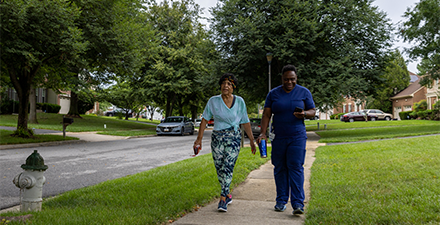You want blunt? The US Department of Health and Human Services can do blunt—at least when it comes to physical activity (PA) recommendations for Americans.
"Adults should move more and sit less throughout the day," HHS says in its latest edition of nationwide guidelines for PA. "Some physical activity is better than none."
That's the bottom-line recommendation that HHS rolled out this week in its revised Physical Activity Guidelines for Americans. And there's arguably little room for nuance: according to HHS, 80% of all Americans are not meeting current PA recommendations, a failure that is contributing the prevalence of a host of chronic health conditions.
The new guidelines, with their emphasis on the importance of movement to prevent disease and extend life no matter an individual's age, echo many perspectives long-championed by APTA and its members.
"These revised guidelines create a clear roadmap for where we need to be as a nation, and the physical therapy profession is here to help people get the movement they need to optimize their health," said APTA President Sharon L. Dunn, PT, PhD. "APTA will continue to advocate on behalf of our patients to ensure that our nation’s public policies align with these recommendations."
The revision, the first in 10 years, doesn't alter many of the now-familiar PA goals for adults: at least 150 minutes of moderate-intensity PA per week, or 75 or more minutes of vigorous-intensity PA per week. But the new guidelines further reinforce the benefit of PA at any level by removing statements saying that PA must occur for at least 10 minutes to be effective, and by clarifying that virtually any kind of movement is better than nothing. "Adults who sit less and do any amount of moderate-to-vigorous [PA] gain some health benefits," according to the guidelines.
The guidelines themselves vary by age and other factors. Here are the basics for each group identified by HHS.
Preschool-aged children (3 to 5 years): HHS recommends that this age group "should be physically active throughout the day" and that caregivers "should encourage active play that includes a variety of activity types."
Children and adolescents (6 to 17 years): The guidelines recommend 60 minutes or more per day of moderate-to-vigorous PA; with at least 3 days of vigorous-intensity PA per week, at least 3 days of muscle-strengthening PA per week, and at least 3 days of bone-strengthening PA per week.
Adults: 150 minutes per week of moderate-intensity PA, or 75 or more minutes per week of high-intensity PA is recommended for adults; at least 2 or more days per week should include muscle-strengthening activities.
Older adults: If possible, 150 minutes per week of moderate-intensity PA, tempered by an individual's "level of [PA] relative to their fitness," and a clear understanding of how various chronic conditions can affect the ability to reach PA goals. No matter what PA level is achieved, activities should include balance training, aerobic, and muscle-strengthening activities.
Women who are pregnant and postpartum: The guidelines recommend at least 150 minutes of moderate-intensity PA per week, spread throughout the week, during both pregnancy and postpartum. The guidelines also advise that women "who are habitually engaged in vigorous-intensity aerobic activity or who were physically active before pregnancy can continue these activities during pregnancy and the postpartum period."
Adults with chronic health conditions and/or disabilities: These adults should follow the same targets as nonsymptomatic adults, but with a recommendation that should a chronic condition or disability interfere with their ability to meet these guidelines, PA should occur to whatever extent possible; individuals should avoid inactivity. The guidelines also recommend that people with chronic conditions "consult with a health care professional or [PA] specialist about the types and amounts of activity appropriate for their abilities and chronic conditions."
A summary of the guidelines was featured in JAMA, accompanied by an editorial that emphasizes the importance of educating the public on the idea that PA has health benefits no matter the scale of the effort.
"Probably the most important message…is that the greatest health benefits accrue by moving from none to even small amounts of [PA], especially if that activity is moderate…to vigorous..." editorial authors write. "The key point for patients is that large health benefits accrue from even small amounts of [PA] and that even short-duration activity lasting less than 10 minutes is beneficial."
The JAMA editors also think that clinicians need to take care to avoid an overly cautious approach to PA recommendations for patients, writing that they "must avoid being a barrier to [PA] because of concerns about the cardiovascular and orthopedic risks…." They describe those risks as "extremely small with gradually progressive [PA]."
Given PA's demonstrated effects on both physical and emotional well-being, and the relatively low costs involved in incorporating PA into patient lifestyles, "clinicians cannot afford to allow patients to miss out on this inexpensive path to healthier lives," the editorial authors write.
Visit APTA's prevention and wellness webpage for resources on how physical therapists and physical therapist assistants can help individuals become more physically active, and share the latest PA information from APTA's consumer-focused MoveForwardPT.com with your patients, clients, and others interested in the benefits of exercise and movement. Want to connect with others interested in physical therapy's role in improving health? Join APTA's Council on Prevention, Health Promotion, and Wellness.
